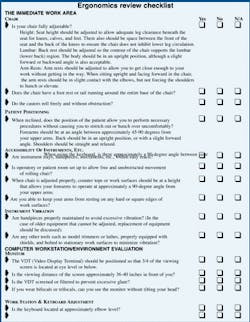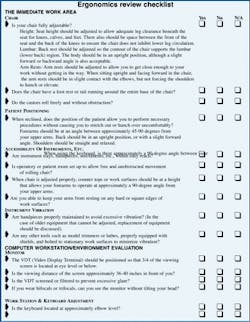Safety Check
Our checklist on pages 52-53 helps you determine if your operatory is a safe place to work.
Charron Contival
Ergonomics, defined as a study of the workplace, pays specific attention to reducing or eliminating injuries - specifically repetitive motion injuries. Most workplace modifications are comparatively inexpensive. They range from adjustable chairs or foot rests to workstations that have variable work surfaces. Such alterations can significantly reduce workplace stress.
How exactly can dental employees evaluate a specific work area? What do they look for? What types of tasks make you most at risk for injuries? What are some of the corrective actions that can be taken to reduce those risks.
"Signal risk factors" (legalese for "red flags") in many jobs alert us to an increased risk of repetitive motion injuries. In other words, the more time during your work shift that you spend doing certain types of tasks, the bigger your chances are of suffering this kind of injury. These factors include performing the same motion or motion pattern every few seconds, the practice of fixed or awkward postures, the use of vibrating or impact tools or equipment, using forceful hand exertions, and unassisted frequent or heavy lifting.
While there is no hard and fast rule that specifies how long each employee should perform these tasks during a work shift, a good rule of thumb seems to be: If your daily duties include two to four hours spent at these types of activities, you may be at increased risk. To clarify, we`re talking about two to four hours of continuous activity without breaks or pauses).
As with any evaluation, you must take into account the individual`s age, weight, physical condition, etc. Due to physical tone and personal work habits, a dental hygienist in her late 30s or 40s may have less risk of repetitive motion injuries than someone in her 20s, if the 20 year-old is less attentive to her own practices and methods of performing job functions.
There are no absolutes in this type of review. The related charts on pages 52-53 help dental personnel examine some specific parts of your work place:
In closing, keep in mind that you are the first line of defense for your own health. By developing good work practices, and being alert to potential problems, you can reduce or eliminate minor injuries before they turn into major problems. It`s always easier to treat a condition such as repetitive motion injuries in their early stages. Ignoring the pain could lead to chronic or serious complications.
Many employees we speak with in our seminars and workshops have never talked over ergonomic issues with their employer, for fear that they`ll be viewed as a "problem employee" or a "trouble-maker." Don`t make this mistake. It`s your employer`s responsibility to make sure your work environment is adapted to the worker, but it`s your responsibility to bring problems or concerns to your employer`s attention. When it comes to your health, you have to be proactive.
Charron Contival is a free-lance writer, photographer, and business consultant based in Hollister, Calif. As the owner of a consulting firm that assists clients with OSHA-related issues, she has provided in-depth training on a variety of technical, regulatory, and procedural topics. She can be contacted at (408) 637-5599.

